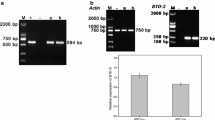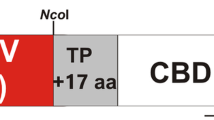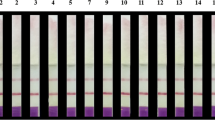Abstract
Expression of strong antimicrobial peptides in plants is of great interest to combat a wide range of plant pathogens. To bring the Dermaseptin B1 (DrsB1) peptide to the intimate contact of the plant pathogens cell wall surface, the DrsB1 encoding sequence was fused to the C-terminal part of the two copies of the chitin-binding domain (CBD) of the Avr4 effector protein and used for Agrobacterium rhizogenes-mediated transformation. The expression of the recombinant protein in the tobacco hairy roots (HRs) was confirmed by molecular analysis. Antimicrobial activity analysis of the recombinant protein purified from the transgenic HRs showed that the (CBD)2-DrsB1 recombinant protein had a significant (p < 0.01) antimicrobial effect on the growth of different fungal and bacterial pathogens. The results of this study indicated that the recombinant protein had a higher antifungal activity against chitin-producing Alternaria alternata than Pythium spp. Scanning electron microscopy images demonstrated that the recombinant protein led to fungal hypha deformation, fragmentation, and agglutination of growing hypha, possibly by dissociating fungal cell wall components. In vitro evidences suggest that the expression of the (CBD)2-DrsB1 recombinant protein in plants by generating transgenic lines is a promising approach to produce disease-resistant plants, resistance to chitin-producing pathogenic fungi.






Similar content being viewed by others
Change history
12 February 2019
The original version of this article unfortunately contained a mistake in the unit “μg/l”. The unit “μg/l” should be corrected to “μg/ml” throughout the paper.
References
Terra, I., Portugal, C., & Becker-Ritt, A. (2015). Plant antimicrobial peptides. The battle against microbial pathogens: Basic science, technological advances and educational programs (pp. 199–207). Spain: Formatex.
Marcos, J. F., Munoz, A., Perez-Paya, E., Misra, S., & Lopez-Garcia, B. (2008). Identification and rational design of novel antimicrobial peptides for plant protection. Annual Review of Phytopathology, 46, 273–301.
Omardien, S., Brul, S., & Zaat, S. A. (2016). Antimicrobial activity of cationic antimicrobial peptides against gram-positives: Current progress made in understanding the mode of action and the response of bacteria. Frontiers in Cell and Developmental Biology, 4, 111.
Alpizar, E., Dechamp, E., Lapeyre-Montes, F., Guilhaumon, C., Bertrand, B., Jourdan, C., Lashermes, P., & Etienne, H. (2008). Agrobacterium rhizogenes-transformed roots of coffee (Coffea arabica): Conditions for long-term proliferation, and morphological and molecular characterization. Annals of Botany, 101(7), 929–940.
Zasloff, M. (2002). Antimicrobial peptides of multicellular organisms. Nature Biotechnology, 415, 389–395.
Holaskova, E., Galuszka, P., Frebort, I., & Oz, M. T. (2015). Antimicrobial peptide production and plant-based expression systems for medical and agricultural biotechnology. Biotechnology Advances, 33(6 Pt 2), 1005–1023.
Nicolas, P., & Ladram, A. (2013) Dermaseptins. In Handbook of biologically active peptides (2nd ed., pp. 350–363). Amsterdam: Elsevier
Osusky, M., Osuska, L., Kay, W., & Misra, S. (2005). Genetic modification of potato against microbial diseases: In vitro and in planta activity of a dermaseptin B1 derivative, MsrA2. Theoretical and Applied Genetics, 111(4), 711–722.
Xu, X., & Lai, R. (2015). The chemistry and biological activities of peptides from amphibian skin secretions. Chemical Reviews, 115(4), 1760–1846.
Nicolas, P., & Amri, E., C. (2009). The dermaseptin superfamily: A gene-based combinatorial library of antimicrobial peptides. Biochimica et Biophysica Acta (BBA)-Biomembranes, 1788(8), 1537–1550.
Galanth, C., Abbassi, F., Lequin, O., Ayala-Sanmartin, J., Ladram, A., Nicolas, P., & Amiche, M. (2009). Mechanism of antibacterial action of dermaseptin B2 interplay between helix-hinge-helix structure and membrane curvature strain. Biochemistry, 48, 313–327.
Melo, M. N., Ferre, R., & Castanho, M. A. (2009). Antimicrobial peptides: Linking partition, activity and high membrane-bound concentrations. Nature Reviews Microbiology, 7(3), 245–250.
Brogden, K. A. (2005). Antimicrobial peptides: Pore formers or metabolic inhibitors in bacteria? Nature Reviews Microbiology, 3(3), 238–250.
Findlay, B., Zhanel, G. G., & Schweizer, F. (2010). Cationic amphiphiles, a new generation of antimicrobials inspired by the natural antimicrobial peptide scaffold. Antimicrobial Agents and Chemotherapy, 54(10), 4049–4058.
Frederiksen, R. F., Paspaliari, D. K., Larsen, T., Storgaard, B. G., Larsen, M. H., Ingmer, H., Palcic, M. M., & Leisner, J. J. (2013). Bacterial chitinases and chitin-binding proteins as virulence factors. Microbiology, 159(Pt 5), 833–847.
Manjeet, K., Purushotham, P., Neeraja, C., & Podile, A. R. (2013). Bacterial chitin binding proteins show differential substrate binding and synergy with chitinases. Microbiological Research, 168(7), 461–468.
Suetake, T., Tsuda, S., Kawabata, S., Miura, K., Iwanaga, S., Hikichi, K., Nitta, K., & Kawano, K. (2000). Chitin-binding proteins in invertebrates and plants comprise a common chitin-binding structural motif. Journal of Biological Chemistry, 275(24), 17929–17932.
van den Burg, H. A., Harrison, S. J., Joosten, M. H., Vervoort, J., & de Wit, P. J. (2006). Cladosporium fulvum Avr4 protects fungal cell walls against hydrolysis by plant chitinases accumulating during infection. Molecular Plant-Microbe Interactions, 19(12), 1420–1430.
Li, C., Blencke, H. M., Paulsen, V., Haug, T., & Stensvag, K. (2010). Powerful workhorses for antimicrobial peptide expression and characterization. Bioengineered Bugs, 1(3), 217–220.
Kuo, Y.-C., Tan, C.-C., Ku, J.-T., Hsu, W.-C., Su, S.-C., Lu, C.-A., & Huang, L.-F. (2013). Improving pharmaceutical protein production in Oryza sativa. International Journal of Molecular Sciences, 14(5), 8719–8739.
Chahardoli, M., Fazeli, A., & Ghabooli, M. (2018). Recombinant production of bovine Lactoferrin-derived antimicrobial peptide in tobacco hairy roots expression system. Plant Physiology and Biochemistry, 123, 414–421.
Aleinein, R., Schäfer, H., & Wink, M. (2015). Rhizosecretion of the recombinant antimicrobial peptide ranalexin from transgenic tobacco hairy roots. RRJBS Phytopathol Gene Diseas, 1, 45–55.
Sharifi, S., Sattari, T. N., Zebarjadi, A., Majd, A., & Ghasempour, H. (2014). The influence of Agrobacterium rhizogenes on induction of hairy roots and ss-carboline alkaloids production in Tribulus terrestris L. Physiology and Molecular Biology of Plants, 20(1), 69–80.
Moghadam, A., Niazi, A., Afsharifar, A., & Taghavi, S. M. (2016). Expression of a recombinant anti-HIV and anti-tumor protein, MAP30, in Nicotiana tobacum hairy roots: A pH-stable and thermophilic antimicrobial protein. PLoS ONE, 11(7), e0159653.
Carlín, A. P., Tafoya, F., Alpuche Solís, A. G., & Pérez-Molphe-Balch, E. (2015). Effects of different culture media and conditions on biomass production of hairy root cultures in six Mexican cactus species. In Vitro Cellular & Developmental Biology-Plant, 51(3), 332–339.
Fischer, R., Stoger, E., Schillberg, S., Christou, P., & Twyman, R. M. (2004). Plant-based production of biopharmaceuticals. Current Opinion in Plant Biology, 7(2), 152–158.
Ron, M., Kajala, K., Pauluzzi, G., Wang, D., Reynoso, M. A., Zumstein, K., Garcha, J., Winte, S., Masson, H., & Inagaki, S. (2014). Hairy root transformation using Agrobacterium rhizogenes as a tool for exploring cell type-specific gene expression and function using tomato as a model. Plant Physiology, 166(2), 455–469.
Zhou, M.-L., Zhu, X.-M., Shao, J.-R., Tang, Y.-X., & Wu, Y.-M. (2011). Production and metabolic engineering of bioactive substances in plant hairy root culture. Applied Microbiology and Biotechnology, 90(4), 1229–1239.
Skosyrev, V. S., Rudenko, N. V., Yakhnin, A. V., Zagranichny, V. E., Popova, L. I., Zakharov, M. V., & Gorokhovatsky, A. Y., & V., L. M. (2003). EGFP as a fusion partner for the expression and organic extraction of small polypeptides. Protein Expression and Purification, 27, 55–62.
Murashige, T., & Skoog, F. (1962). A revised medium for rapid growth and bio agsays with tohaoco tissue cultures. Physiologia Plantarum, 15, 26.
Joosten, M., Vogelsang, R., Cozijnsen, T. J., Verberne, M. C., & De Wit, P. (1997). The biotrophic fungus Cladosporium fulvum circumvents Cf-4-mediated resistance by producing unstable AVR4 elicitors. The Plant Cell, 9(3), 367–379.
Sulson, J. E., & Waterston, R. (1998). Genome sequence of the nematode C. elegans: A platform for investigating biology. Science, 282(5396), 2012–2018.
Yevtushenko, D. P., & Misra, S. (2007). Comparison of pathogen-induced expression and efficacy of two amphibian antimicrobial peptides, MsrA2 and temporin A, for engineering wide-spectrum disease resistance in tobacco. Plant Biotechnology Journal, 5(6), 720–734.
Doyle, J., & Doyle, J. (1987). CTAB DNA extraction in plants. Phytochemical Bulletin, 19, 11–15.
Chang, S., Puryear, J., & Cairney, J. (1993). A simple and efficient method for isolating RNA from pine trees. Plant Molecular Biology Reporter, 11(2), 113–116.
Nicot, N., Hausman, J.-F., Hoffmann, L., & Evers, D. (2005). Housekeeping gene selection for real-time RT-PCR normalization in potato during biotic and abiotic stress. Journal of Experimental Botany, 56(421), 2907–2914.
Bradford, M. M. (1976). A rapid and sensitive method for the quantitation of microgram quantities of protein utilizing the principle of protein-dye binding. Analytical Biochemistry, 72(1–2), 248–254.
Che, Y. Z., Li, Y. R., Zou, H. S., Zou, L. F., Zhang, B., & Chen, G. Y. (2011). A novel antimicrobial protein for plant protection consisting of a Xanthomonas oryzae harpin and active domains of cecropin A and melittin. Microbial Biotechnology, 4(6), 777–793.
Roberts, W. K., & Selitrennikoff, C. P. (1986). Isolation and partial characterization of two antifungal proteins from barley. Biochimica et Biophysica Acta (BBA)-General Subjects, 880(2–3), 161–170.
Feng, W., & Zheng, X. (2007). Essential oils to control Alternaria alternata in vitro and in vivo. Food Control, 18(9), 1126–1130.
Mor, A., & Nicolas, P. (1994). Isolation and structure of novel defensive peptides from frog skin. European Journal of Biochemistry, 219(1-2), 145–154.
Mor, A., Amiche, M., & Nicolas, P. (1994). Structure, synthesis, and activity of dermaseptin b, a novel vertebrate defensive peptide from frog skin: Relationship with adenoregulin. Biochemistry, 33(21), 6642–6650.
Strahilevitz, J., Mor, A., Nicolas, P., & Shai, Y. (1994). Spectrum of antimicrobial activity and assembly of dermaseptin-b and its precursor form in phospholipid membranes. Biochemistry, 33(36), 10951–10960.
Gaume, A., Komarnytsky, S., Borisjuk, N., & Raskin, I. (2003). Rhizosecretion of recombinant proteins from plant hairy roots. Plant Cell Reports, 21(12), 1188–1193.
Osusky, M., Zhou, G., Osuska, L., Hancock, R. E., Kay, W. W., & Misra, S. (2000). Transgenic plants expressing cationic peptide chimeras exhibit broad-spectrum resistance to phytopathogens. Nature Biotechnology, 18(11), 1162.
Osusky, M., Osuska, L., Hancock, R. E., Kay, W. W., & Misra, S. (2004). Transgenic potatoes expressing a novel cationic peptide are resistant to late blight and pink rot. Transgenic Research, 13(2), 181–190.
Jashni, M. K., Dols, I. H., Iida, Y., Boeren, S., Beenen, H. G., Mehrabi, R., Collemare, J., & de Wit, P. J. (2015). Synergistic action of a metalloprotease and a serine protease from Fusarium oxysporum f. sp. lycopersici cleaves chitin-binding tomato chitinases, reduces their antifungal activity, and enhances fungal virulence. Molecular Plant-Microbe Interactions, 28(9), 996–1008.
Firouzabadi, F. N., Kok-Jacon, G. A., Vincken, J.-P., Ji, Q., Suurs, L. C., & Visser, R. G. (2007). Fusion proteins comprising the catalytic domain of mutansucrase and a starch-binding domain can alter the morphology of amylose-free potato starch granules during biosynthesis. Transgenic Research, 16(5), 645–656.
Nazarian-Firouzabadi, F., Trindade, L. M., & Visser, R. G. (2012). Production of small starch granules by expression of a tandem-repeat of a family 20 starch-binding domain (SBD3-SBD5) in an amylose-free potato genetic background. Functional Plant Biology, 39(2), 146–155.
Guillen, D., Santiago, M., Linares, L., Perez, R., Morlon, J., Ruiz, B., Sanchez, S., & Rodriguez-Sanoja, R. (2007). Alpha-amylase starch binding domains: Cooperative effects of binding to starch granules of multiple tandemly arranged domains. Applied and Environmental Microbiology, 73(12), 3833–3837.
Reddy, K., Yedery, R., & Aranha, C. (2004). Antimicrobial peptides: Premises and promises. International Journal of Antimicrobial Agents, 24(6), 536–547.
Yevtushenko, D. P., & Misra, S. (2012) Transgenic expression of antimicrobial peptides in plants: Strategies for enhanced disease resistance, improved productivity, and production of therapeutics. In ACS Symposium Series, 1095, pp. 445–458.
Author information
Authors and Affiliations
Corresponding author
Additional information
Publisher’s Note
Springer Nature remains neutral with regard to jurisdictional claims in published maps and institutional affiliations.
Electronic Supplementary Material
Below is the link to the electronic supplementary material.
Rights and permissions
About this article
Cite this article
Shams, M.V., Nazarian-Firouzabadi, F., Ismaili, A. et al. Production of a Recombinant Dermaseptin Peptide in Nicotiana tabacum Hairy Roots with Enhanced Antimicrobial Activity. Mol Biotechnol 61, 241–252 (2019). https://doi.org/10.1007/s12033-019-00153-x
Published:
Issue Date:
DOI: https://doi.org/10.1007/s12033-019-00153-x




